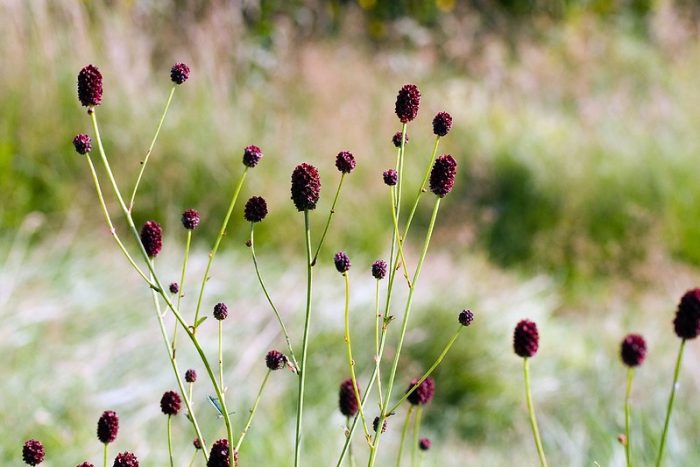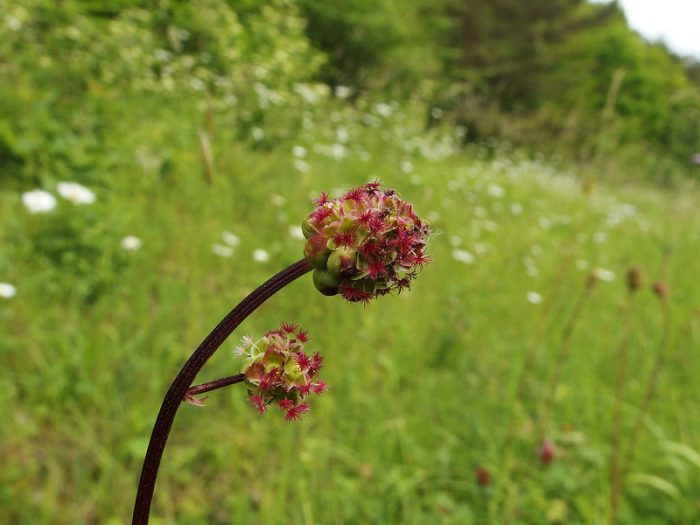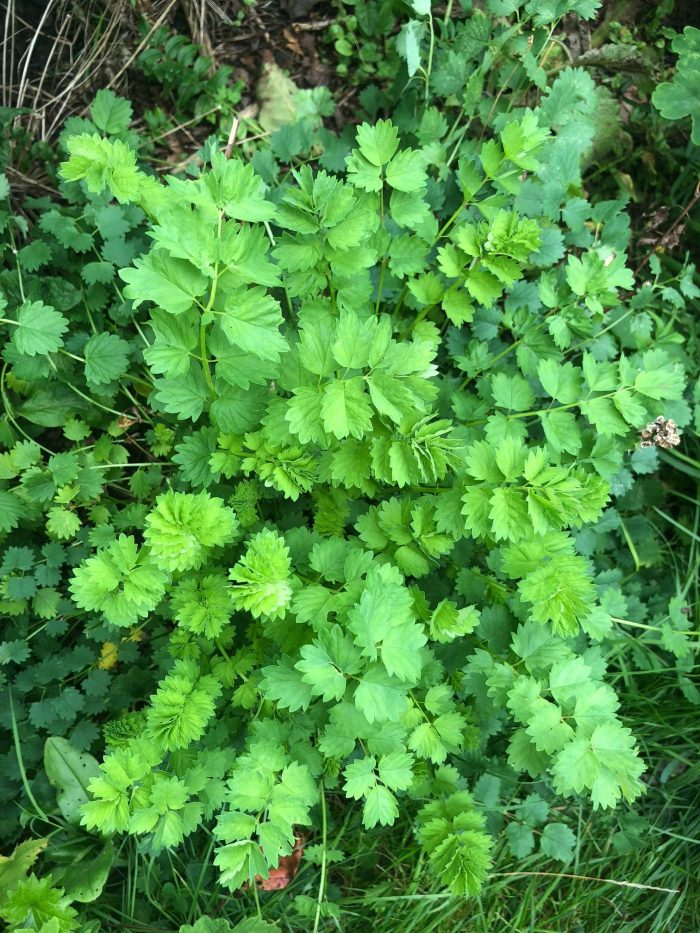Salad Burnet: Recipes and Growing Advice
Salad Burnet (Sanguisorba minor) is a native of Europe, Asia and Africa, naturalised in North America. It is a relatively common sun-loving plant that grows wild in meadows.
It forms dense low clumps with flower spikes 40-90cm tall. Its flowers are attractive, but modest – small, reddish-green, oval clusters. Salad burnet was used as a vegetable, spice and medicinal plant since antiquity.
How to grow salad burnet
Salad burnet prefers sun and limestone soils. It is hardy to zone 4 (can withstand temperatures below -28C).
It flowers in June and when flower stalks develop, the growth of leaves stalls. Therefore it is best to cut down spent flower stalks and old leaves in July, when the flowering is over. Once this is done, the growth will resume with even greater vigour than in spring and continue until very late autumn.
Salad burnet naturally grows on poor soils. But if it is grown for leaves, it is best to give it richer and more moist soil. Both can be achieved by mulching the plants annually with compost. As a result, leaves will be more tender and milder tasting, and more readily produced.
In addition, if you are growing salad burnet as a leafy vegetable, and don’t need it to produce seeds, you can remove flower stalks as they start appearing in June. This and regulalry removing old leaves will help to avoid a pause in growth in mid-summer.
Salad Burnet plants and seeds can be bought from wild-flower nurseries, such as Naturescape.
Great burnet (Sanguisorba officinalis)
Salad burnet has a larger and more showy relative, Great burnet (Sanguisorba officinalis). It is loved by florists and often grown as a decorative garden plant.
It has dramatic, very dark red flowers on tall stalks, and indeed look striking in flower arrangements and the garden. Its flowers are long-lasting and so in borders it stays beautiful for a very long time, from June to September.
Great burnet is also a very important medicinal plant, used in herbal medicine to treat a wide range of conditions, including bleeding, dysentery and salmonella infection.

Salad burnet benefits
Though salad burnet cannot rival medicinal and decorative properties of its relative, Great burnet, it is still a very attractive garden plant. Most importantly, it is the variety of choice for culinary use, because of its tender and milder tasting leaves. It is an excellent addition to a vegetable garden for reasons explained below.
Convenience
Salad burnet starts growing early in spring and produces masses of leaves. It gives a constant supply of leaves from spring to late autumn, apart from a pause during flowering, as explained in the growing notes above. New leaves grow fast and are nearly always available, even if they are picked every day.
The productivity of salad burnet late in the season, particularly in late autumn, is very useful, because this is the time when most garden salads are long past their best.
Salad burnet is non-invasive, and a very attractive and well-behaved plant for a vegetable garden. As a wild plant is it undemanding and not prone to pests and diseases. It is therefore very easy to grow organically.
Beauty
Young leaves of salad burnet look amazing is salads and as garnish. They resemble lace because they are highly divided, and are a lovely shade of bright green. They look fresh, elegant and unusual.
Taste and smell
Young leaves of salad burnet have a nutty and slightly bitter taste. They are therefore best used when very young, as they become more bitter when they mature. Very dry weather and poor soil have a similar effect, making leaves more bitter and tougher.
To overcome bitterness, it is a good idea to mix salad burnet in salads with more neutral tasing greens. And by far the healthiest and tastiest salads are a rich mixture of cultivated and wild edible plants from your garden!
One of the main attractions of salad burnet is its very fresh smell, resembling that of cucumber. The smell is preserved in salads, but is lost when leaves are cooked.
Nutrition
As a wild plant salad burnet is highly nutritious and has superior vitamin and mineral content.
Scientific studies have demonstrated that it has important health benefits. According the the Forest Service of the US Department of Agriculture:
A Spanish study found small burnet (Salad burnet or Sanguisorba minor ‘small burnet’) extracts exhibited anti-HIV activity in vitro. In Germany, small burnet extracts significantly lowered blood sugar levels of laboratory mice treated with the extracts compared to control mice. In a Turkish study, small burnet extracts gave significant protection against gastric ulcers in laboratory mice. And in an Iranian study, crude extracts from small burnet collected in Iran and Canada showed fungicidal activity.

Salad burnet recipes
Sandwiches
Use very young tender leaves on sandwiches, in the same way as watercress.
Salads
Add leaves to salads – very young leaves are the best.
Soups and vegetable dishes
Use in the same way as spinach in soups, vegetable dishes and fillings for pies. When cooking leaves, remove their stalks. The stalks harden when cooked, so it is best to remove them straight away.
Salad burnet and potato salad
Ingredients:
40g young salad burnet leaves
20g spring onions
50g potatoes
Mayonnaise and salt to taste
Method:
Wash salad burnet leaves, put in boiling water and cook for 1 minute.
Cool, dry lightly and chop.
Chop spring onions.
Cook and chop potatoes.
Mix potatoes and greens together, and add mayonnaise and salt to taste.
Frankfurt sauce
The best known dish including salad burnet is without doubt the Frankfurt sauce (Grüne Soße. ‘green sauce’ in German). It is a classic German dish that became popular in the 18th century.
Apparently it was a favourite dish of the famous writer Johann Wolfgang von Goethe (1749-1832). He was born in Frankfurt am Main and so would have been a good judge of its cuisine.
Seven herbs
In its classic form the Frankfurt sauce includes seven herbs: sorrel, parsley, cress, borage, chervil, chives and salad burnet. None of these is particularly exotic or difficult to find. Most people grow parsley and chives in their gardens.
Sorrel is a very common wild plant that grows on many meadows and lawns. Cress is a very common weed and is also present in many gardens. Its peppery taste is similar to that of watercress that can be used instead.
If you have ever sown borage seeds, it will continue to sprout in your garden, as it does in mine. It is an annual plant with beautiful blue flowers. It’s young leaves smell of cucumber and are great in salads.
Young chervil plants and seeds are widely sold in garden shops for introduction to vegetable gardens. There is also a common wild chervil, but it is very difficult to distinguish from deadly poisonous plants of the same Umbelliferae family. It is therefore extremely dangerous to collect it from the wild. It must be bought from shops.
In the Frankfurt region in Germany things are easy for lovers of the sauce – bundles of mixed herbs for Grüne Soße are sold at markets. If you, however, cannot find the exact plants where you live, use substitutes instead. Depending on the season it could be dill, spinach, spring onions and basil, and available wild herbs, such as dandelion, chicory, cooked nettles, chickweed and many other plants.
See my post 10 Edible Wild Greens for Autumn and Winter for plants available through much of the year.

Ingredients
200g mixed herbs
250g soured cream or Greek yogurt
3 eggs
6 tbs olive oil
3 tbs white wine or apple vinegar
2 teaspoons mustard or lemon juice
Salt and pepper to taste.
Method
Boil eggs, cool and separate egg yolks and whites.
Crush egg yolks with a fork in a bowl. Add olive oil, vinegar and mustard (or lemon juice) and mix to a paste.
Add soured cream.
Chop the herbs and egg whites by hand or in a blender. The texture should be somewhat rough rather than completely smooth.
Add the herbs and egg whites to a bowl and mix all ingredients to achieve an even consistency.
Add salt and pepper to taste.
Leave for about an hour at room temperature to infuse before serving.
The sauce combines very well with many products. It is highly nutritious due to the presence of several herbs. Use it with beef, fish, boiled and baked potatos and with egg dishes.
Posts related to ‘Salad Burnet: Recipes and Growing Advice’
Wild Salad: Why should we Eat Foraged Greens?
10 Edible Wild Greens for Autumn and Winter
Growing Chicory for Leaves, Flowers and Coffee
Chickweed: A Weed or a Delicious Salad Crop?
Dandelion as a Vegetable: a Beautiful and Useful Gift of Nature
How to Grow Winter Salad Leaves on the Patio
How to Grow Wild Flowers in the Garden
Pin ‘Salad Burnet: Recipes and Growing Advice’ for later

